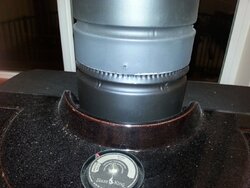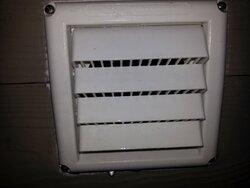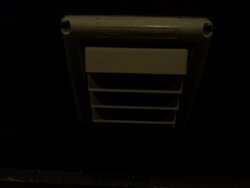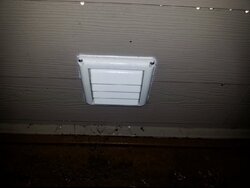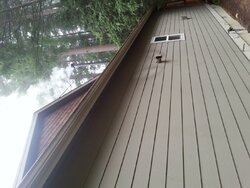Need Help With Smoke Leaking Into Home
- Thread starter Parallax
- Start date
-
Active since 1995, Hearth.com is THE place on the internet for free information and advice about wood stoves, pellet stoves and other energy saving equipment.
We strive to provide opinions, articles, discussions and history related to Hearth Products and in a more general sense, energy issues.
We promote the EFFICIENT, RESPONSIBLE, CLEAN and SAFE use of all fuels, whether renewable or fossil.
You are using an out of date browser. It may not display this or other websites correctly.
You should upgrade or use an alternative browser.
You should upgrade or use an alternative browser.
- Status
- Not open for further replies.
Poindexter
Minister of Fire
Do you have a pair of gloves thick enough to pull the cat probe and lift the enameled top off without hurting yourself?
I can assure you you won't want to carry the top very far even if it is stone cold.
I can assure you you won't want to carry the top very far even if it is stone cold.
Poindexter
Minister of Fire
What prevents sparks from coming through that intake into the house? Or smoke from coming out?
I haven't run an OAK yet. On the Ashford there is a air intake on the bottom at the back in the center. Your (and my) intake air runs up the back of the stove to the thermostatically controlled air valve at the top, and then back down a ways before forking into the left and right air chambers in the firebox that feed the airwash with preheated air just inside the loading door at the front of the unit.
Your not getting sparks back out of that unless you load the stove with gunpowder.
Ok, cool.
I've pulled off the enamel top a few times. Can do it again. I assume I should reinsert the probe into the hole.
I've pulled off the enamel top a few times. Can do it again. I assume I should reinsert the probe into the hole.
Another clue (or maybe not). When I open the t-stat all the way, there's more air available for the fire than when it's turned down. But when I leave the door of the stove open just a crack, there's way, way more air for the fire (and it's not even close). When the stove was brand new, I'm not sure there was as much of a difference. Was still, of course, more air when the door was open. But maybe not to this extent. I've been wondering if the OAK could be clogged.
I am curious what removing the cast top will do. Not being critical i just dont follow.Do you have a pair of gloves thick enough to pull the cat probe and lift the enameled top off without hurting yourself?
I can assure you you won't want to carry the top very far even if it is stone cold.
I'm sniffing around to try to figure out where the smoke smell is coming from. Gotta get my cardboard tube or my cpap mask and hose.
Isaiah53
Member
I believe you were in on the discussion BKVP made about resetting the thermostat knob, but I don't recall if this was your issue or not. I decided to check my Ashford out before I ever fired it as a result of his comment. I found that the damper was set such that it did not move off of its closed setting until the T-stat was around 2.0-2.5 and it would only open 45 degrees at full open. I am not sure if I messed it up in the inspection, but I ended up having to reset the set screw on the damper, not just the outside knob in order to get it to work properly where it would go full closed to full open. It seemed as though the set screw may have come loose (or maybe I accidentally loosened it), but the damper can become disconnected from your T-stat knob.
drz1050
Minister of Fire
drz1050
Minister of Fire
I am curious what removing the cast top will do. Not being critical i just dont follow.
The cast top can act as a diffuser, taking the leak and spreading it out across a wide area. Removing that blocking plate (the cast top) can help to pinpoint it
Sorry if I missed it earlier in the thread, but has your flue been cleaned yet this season? I glanced at some earlier posts and noticed you had been burning sub-par wood for some time, and as I recall you were getting quite a bit of visible smoke outside the house at times (in addition to the indoor smells). Ideally, your stove will not only be smoke-free inside, it will yield very little outside smoke except on start-ups and reloads. If you've been getting lots of smoke, you probably have been producing a fair amount of creosote, too.
I wonder if the cat was actually burning smoke previously in some of your longer, slower burns, or if instead you were largely just smoldering the wet wood and running a creosote factory. Heavy outdoor smoke would indicate the latter. If so, the situation feeds back on itself, as the creosote buildup further restricts draft, creating even more creosote, further restricting draft.
So I'd give the flue a sweep, get a flue probe so you know temps are high enough, and maybe try burning without the OAK just to rule that out. Do not worry about smoke pouring out of the flue-probe hole or the air inlet... once you diagnose and resolve the cause of the smoke and backpuffing, and the system is drafting properly and you are burning dry cord wood, there will be no smoke issue at all.
Think of your flue system like a straw: as long as you are sucking, nothing can spill out the bottom or even out of small seams in the straw, it can only be pulled in. But if the straw is clogged at either the top or the bottom, flow is restricted. For whatever reason(s), your current wood-burning experience is sucking because your flue system isn't! I wouldn't rule anything out yet, even a clogged OAK or a defective stove, but I do believe a few months of burning wet wood and the resulting creosote could be adding to the problem.
I wonder if the cat was actually burning smoke previously in some of your longer, slower burns, or if instead you were largely just smoldering the wet wood and running a creosote factory. Heavy outdoor smoke would indicate the latter. If so, the situation feeds back on itself, as the creosote buildup further restricts draft, creating even more creosote, further restricting draft.
So I'd give the flue a sweep, get a flue probe so you know temps are high enough, and maybe try burning without the OAK just to rule that out. Do not worry about smoke pouring out of the flue-probe hole or the air inlet... once you diagnose and resolve the cause of the smoke and backpuffing, and the system is drafting properly and you are burning dry cord wood, there will be no smoke issue at all.
Think of your flue system like a straw: as long as you are sucking, nothing can spill out the bottom or even out of small seams in the straw, it can only be pulled in. But if the straw is clogged at either the top or the bottom, flow is restricted. For whatever reason(s), your current wood-burning experience is sucking because your flue system isn't! I wouldn't rule anything out yet, even a clogged OAK or a defective stove, but I do believe a few months of burning wet wood and the resulting creosote could be adding to the problem.
That could very well be. Would be a good idea to clean the stack. Was going to order some brushes to do it myself. Perhaps I'll just bring someone in this first time to make sure it's done right.
Here are some photos taken this morning. When I came downstairs, the stove still had tons of fuel but was almost out of the cat range. It seemed like the fire wasn't getting enough air. The t-stat was set to 2 (and it has been adjusted pursuant to BKVP's instructions).
In the past, I might have turned it all the way up. Most of the time it would just fire back up but sometimes it would do nothing for a few moments and then I'd get a giant back puff. This time, not wanting to chance the back puff, I turned it up just a bit. A few minutes later, there was fire in the box. The photo below captures the flames. I then went outside and took these photos. Because the sky was overcast, you can't see the smoke coming from the stack but it was substantial. Hopefully you can at least see the height of the chimney in relation to the peak of the roof.
I later turned the t-stat back down but there was still smoke coming from the stack. Less of it, but it rarely gets to the point where there's no smoke. I don't know if that's normal or problematic. If it is a problem, perhaps it's due to not getting enough air from the OAK.
Also, with regard to the back puffing, was the issue operator error (due to my having turned the t-stat up too fast) or should such things not happen no matter how fast one raises the setting?
(Sorry for the sideways photos. I can take the time to rotate them if anyone needs that in order to glean the information they contain.)
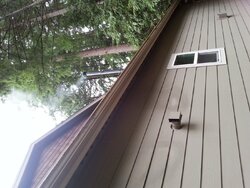

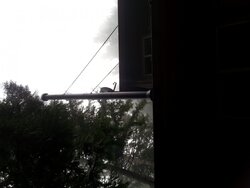
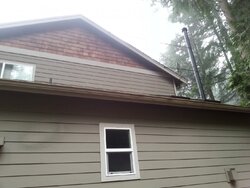
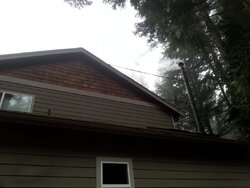
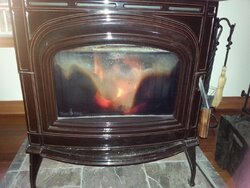
Here are some photos taken this morning. When I came downstairs, the stove still had tons of fuel but was almost out of the cat range. It seemed like the fire wasn't getting enough air. The t-stat was set to 2 (and it has been adjusted pursuant to BKVP's instructions).
In the past, I might have turned it all the way up. Most of the time it would just fire back up but sometimes it would do nothing for a few moments and then I'd get a giant back puff. This time, not wanting to chance the back puff, I turned it up just a bit. A few minutes later, there was fire in the box. The photo below captures the flames. I then went outside and took these photos. Because the sky was overcast, you can't see the smoke coming from the stack but it was substantial. Hopefully you can at least see the height of the chimney in relation to the peak of the roof.
I later turned the t-stat back down but there was still smoke coming from the stack. Less of it, but it rarely gets to the point where there's no smoke. I don't know if that's normal or problematic. If it is a problem, perhaps it's due to not getting enough air from the OAK.
Also, with regard to the back puffing, was the issue operator error (due to my having turned the t-stat up too fast) or should such things not happen no matter how fast one raises the setting?
(Sorry for the sideways photos. I can take the time to rotate them if anyone needs that in order to glean the information they contain.)






Attachments
I'm not sure. There were times when it didn't smoke much at the very beginning and there still are occasions, toward the end of a burn, when I'll look up and see no smoke. But I think it's gotten worse. The fire box seems more starved for air, though this is just my impression.
The dealer doesn't seem to know a lot. He increased the height of the chimney without charge. But yesterday he left a message about waiting to see if the smoke stops getting into the house as the leak gets filled with soot (which is what happened last time). This is a completely unacceptable solution, as the leak would recur every time the stove pipe was opened for cleaning. I've not even asked him about the fact that the chimney smoke is always present. He's not an expert on the Blaze King and would say that's normal.
The dealer doesn't seem to know a lot. He increased the height of the chimney without charge. But yesterday he left a message about waiting to see if the smoke stops getting into the house as the leak gets filled with soot (which is what happened last time). This is a completely unacceptable solution, as the leak would recur every time the stove pipe was opened for cleaning. I've not even asked him about the fact that the chimney smoke is always present. He's not an expert on the Blaze King and would say that's normal.
Tenn Dave
Minister of Fire
I have a different stove all together, but when my cat is engaged there is virtually no visible smoke and no outside smoke smell. Depending on weather conditions, sometimes I get a tiny bit of white water vapor coming out of the stack.That could very well be. Would be a good idea to clean the stack. Was going to order some brushes to do it myself. Perhaps I'll just bring someone in this first time to make sure it's done right.
Here are some photos taken this morning. When I came downstairs, the stove still had tons of fuel but was almost out of the cat range. It seemed like the fire wasn't getting enough air. The t-stat was set to 2 (and it has been adjusted pursuant to BKVP's instructions).
In the past, I might have turned it all the way up. Most of the time it would just fire back up but sometimes it would do nothing for a few moments and then I'd get a giant back puff. This time, not wanting to chance the back puff, I turned it up just a bit. A few minutes later, there was fire in the box. The photo below captures the flames. I then went outside and took these photos. Because the sky was overcast, you can't see the smoke coming from the stack but it was substantial. Hopefully you can at least see the height of the chimney in relation to the peak of the roof.
I later turned the t-stat back down but there was still smoke coming from the stack. Less of it, but it rarely gets to the point where there's no smoke. I don't know if that's normal or problematic. If it is a problem, perhaps it's due to not getting enough air from the OAK.
Also, with regard to the back puffing, was the issue operator error (due to my having turned the t-stat up too fast) or should such things not happen no matter how fast one raises the setting?
(Sorry for the sideways photos. I can take the time to rotate them if anyone needs that in order to glean the information they contain.)
View attachment 152509 View attachment 152509 View attachment 152511 View attachment 152512 View attachment 152513 View attachment 152510
How does one check the OAK for clogging? Just remove and inspect?
Also, could a stack in need of cleaning cause the smoke?
Also, could a stack in need of cleaning cause the smoke?
Absolutly it would reduce draft causing all of your problems.Also, could a stack in need of cleaning cause the smoke?
Yes and run a flexible rod through it we use dryer vent rods and brushesHow does one check the OAK for clogging? Just remove and inspect?
How does one check the OAK for clogging? Just remove and inspect?
Also, could a stack in need of cleaning cause the smoke?
Not unless it was so plugged as to affect draft. Damp wood would be a more likely culprit.
Tenn Dave
Minister of Fire
a clogged cat can certainly cause smoke out the chimney.How does one check the OAK for clogging? Just remove and inspect?
Also, could a stack in need of cleaning cause the smoke?
- Status
- Not open for further replies.
Similar threads
- Replies
- 24
- Views
- 2K
- Replies
- 30
- Views
- 2K
- Replies
- 17
- Views
- 708
- Replies
- 11
- Views
- 1K


